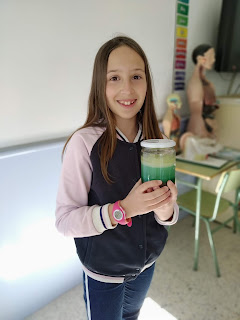Hello, everyone!
In 5th Grade we learning about MATTER and its properties: mass, volume and density.
After calculating the mass and the volume of some solids and liquids, we moved to density.
"Density is the relationship between mass and volume".
Fist of all, we compared a rock and a piece of cork from similar sizes. We all agreed that they occupy the same space (they have the same volume) but the rock is heavier than the cork (it's got a bigger mass). So, we learnt that the rock was DENSER that the cork.
Then, we moved to liquids.
1. First, we observed different liquids that have the same volume but weight different.
2. Then, we put the same quantity of
water,
honey and
vegetable oil in 3 different beakers and we poured small objects inside, in order to observe if they floated or sank. Of course, we made predictions first!
"The denser a liquid is, the easier it is for an object to float on it".
So, we could order the density of the liquids (from most to least):
1. Honey
2. Water
3. Oil
3. We mixed them up and we saw that liquids with different densities don't mix.
4. Then, we tried to mix hot and cold water, to see if they have different densities (they do!):
5. And we did the same with salty or sweet water:
6. Finally, we poured all the liquids we saw at the beginning of the lesson into a container and we could check that...
"Liquids with different densities don't mix".
Now, it's your turn! Why don't you try it at home?
Thank you Maryam, Rihab, Andreea and Elena to share with us your experiment done at home!



























